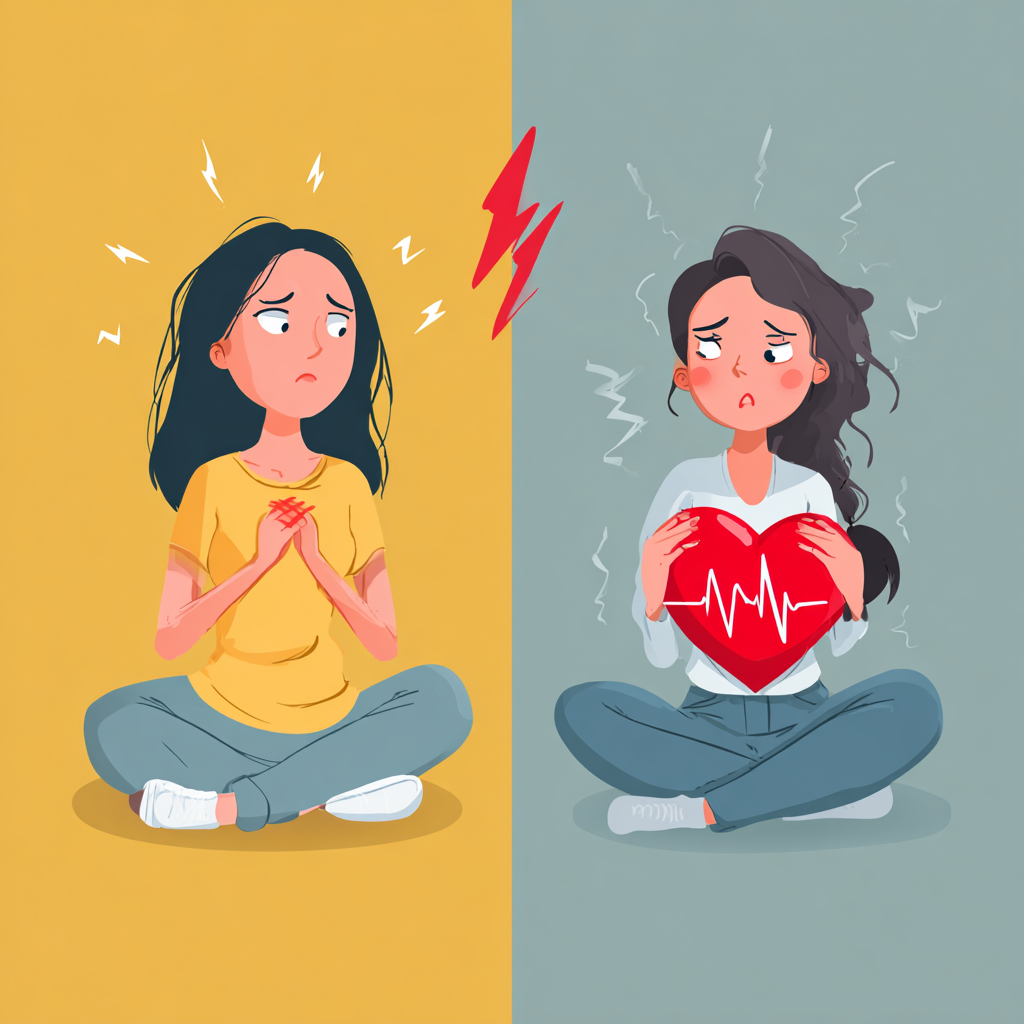Introduction: The Body’s Red Alarms
Imagine your body’s alarm system suddenly going off. For a moment, it’s impossible to tell if it’s a false alarm or a true emergency. This is the terrifying experience of a sudden onset of symptoms like chest pain, shortness of breath, or dizziness. While a heart attack is a critical cardiac event, a panic attack is a neurobiological response that copies many of its symptoms. Both can be intensely overwhelming, but one is a malfunction of the central nervous system, and the other is a failure of the cardiovascular system. We will understand the specific physiological events behind each condition as it is crucial for self-awareness and knowing when to call for help.

Understanding the Panic Attack: A Brain-Body Connection
A panic attack is a sudden, intense surge of fear that triggers the body’s sympathetic nervous system, which controls the “fight-or-flight” response. [1] This series of events is a survival mechanism, but in a panic attack, it’s activated without a real threat. The key driver of this response is the release of epinephrine (also known as adrenaline) and norepinephrine from the adrenal glands into the bloodstream.
Key Changes During a Panic Attack:
- Cardiovascular System: The release of epinephrine causes an immediate increase in heart rate (tachycardia) and blood pressure. This sudden stress on the heart can cause palpitations, which is a sensation of the heart pounding, fluttering, or skipping beats. While this feels like a heart attack, the heart muscle itself is not being damaged.
- Respiratory System: The sudden activation of the sympathetic nervous system triggers hyperventilation (rapid, shallow breathing). This rapid exhalation of carbon dioxide can lead to respiratory alkalosis, a state where the blood’s pH level becomes too high. This change in blood chemistry can cause symptoms like lightheadedness, tingling, and numbness, especially in the hands and around the mouth. [3]
- Musculoskeletal System: The surge of adrenaline primes the muscles for action, leading to muscle tension and trembling or shaking. This tension, particularly in the chest and back, can be perceived as the tight, crushing pain often mistaken for a heart attack.
- Gastrointestinal System: Blood flow is diverted from non-essential functions like digestion to major muscles and organs. This redistribution can cause nausea, stomach cramps, or a “butterflies in the stomach” sensation.
- Nervous System: The overwhelming sense of fear can lead to derealization (a feeling of detachment from your surroundings) or depersonalization (feeling detached from yourself), which are common during panic attacks. The entire episode usually peaks within 10-20 minutes and then slowly subsides as the body metabolizes the stress hormones. [2]
Understanding the Heart Attack
A heart attack, or myocardial infarction (MI), is a life-threatening medical emergency. It occurs when a portion of the heart muscle (the myocardium) is deprived of oxygen-rich blood. This most often happens due to the rupture of an atherosclerotic plaque (a fatty deposit) in a coronary artery, which triggers the formation of a blood clot. This clot then completely blocks the artery, cutting off the blood supply to the heart muscle. Without oxygen, the heart cells begin to die, a process called myocardial necrosis. [4]
Key Changes During a Heart Attack:
- Cardiovascular System: The hallmark symptom is chest pain, known as angina. Unlike the muscle tension of a panic attack, this pain is often described as a crushing, squeezing, or heavy pressure that feels like an immense weight on the chest. The pain may not be localized and can radiate to other parts of the body, a phenomenon called referred pain. This is because the heart and other organs share nerve pathways.
- Referred Pain: The pain of a heart attack commonly spreads to the left arm, shoulder, neck, jaw, or back. [1] While this is the classic symptom, it’s important to note that heart attacks in women and older adults can present with less typical symptoms.
- Systemic Response: The body’s stress response to the heart muscle damage can lead to cold sweats, clammy skin, nausea, or vomiting. This is often mistaken for indigestion or a bad stomach flu. [1]
- Shortness of Breath (Dyspnea): The heart’s reduced pumping ability leads to a backup of fluid in the lungs, making it difficult to breathe. This can be one of the only symptoms in some cases, especially in women.
- Weakness and Fatigue: The heart’s inability to pump blood effectively results in decreased oxygen delivery to the rest of the body, causing sudden, profound weakness or a feeling of being unusually tired.
When to Seek Medical Help
Because the symptoms of a panic attack and a heart attack can be so similar, medical professionals universally recommend erring on the side of caution. The cost of waiting during a heart attack is irreversible heart muscle damage or death. Therefore, if you are experiencing new or unusual chest pain, especially if it is accompanied by other heart attack symptoms, do not wait.
Seek emergency medical help immediately if you experience
- Chest pain or pressure that lasts for more than a few minutes.
- Pain that radiates to your arm, jaw, neck, or back.
- Chest discomfort accompanied by shortness of breath, cold sweats, or nausea.
- New or concerning symptoms, especially if you have risk factors for heart disease, such as a family history, high blood pressure, diabetes, or a history of smoking.
